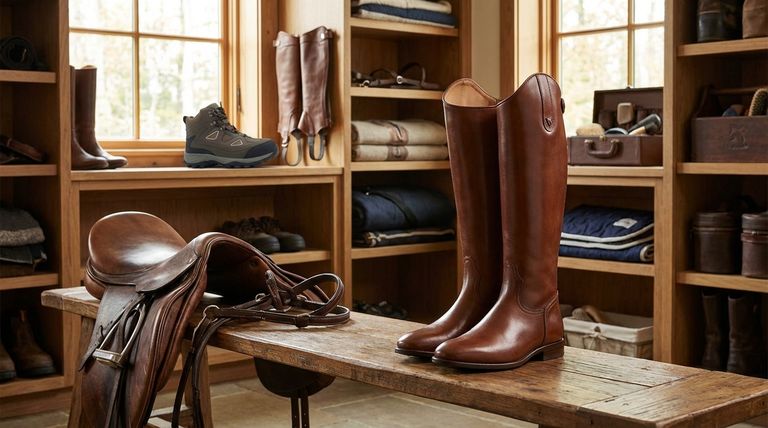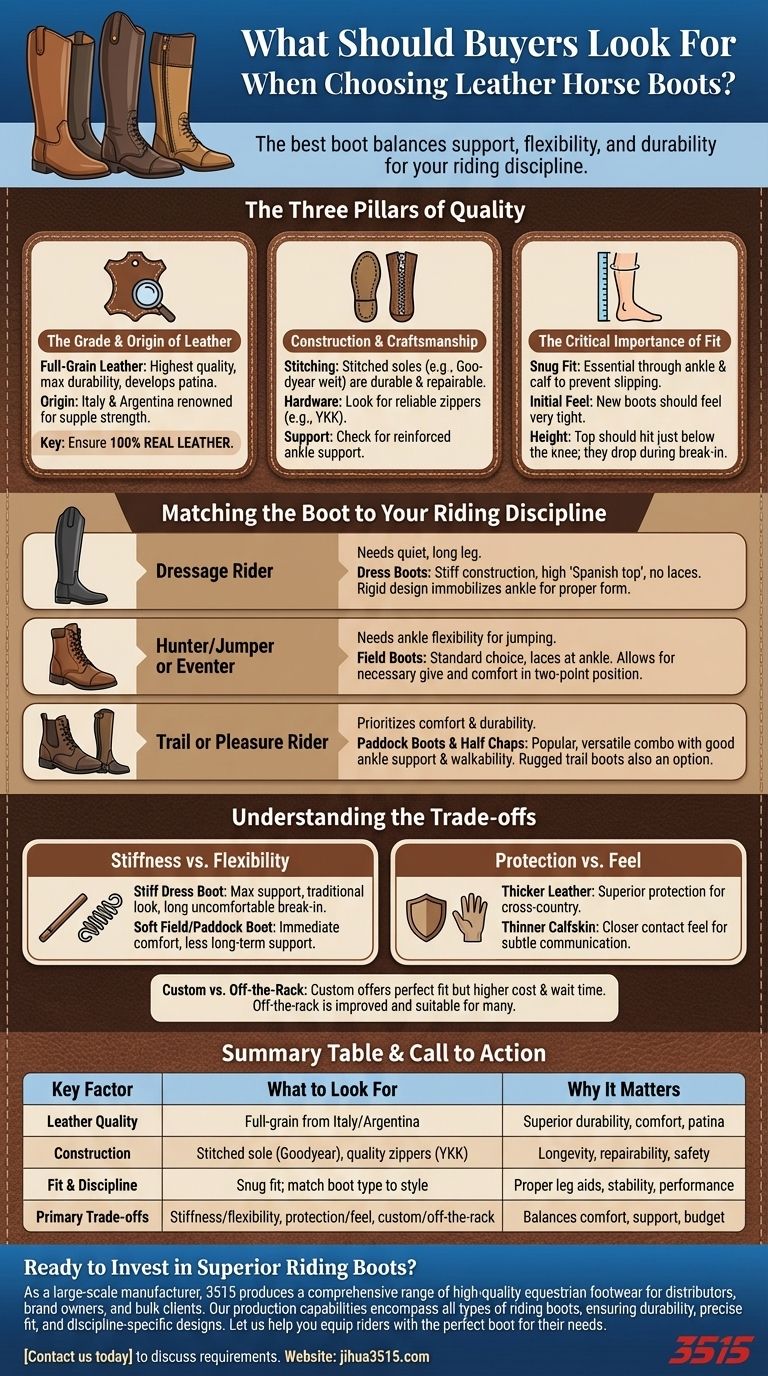When choosing leather horse boots, the most critical factors are the quality and origin of the leather, the boot's construction, and how its specific design aligns with your primary riding discipline. A high-quality boot from a reputable origin like Italy or Argentina will provide superior durability and comfort, but its features must match your needs, whether you're in the dressage ring or on a trail.
The best leather riding boot is not simply the most expensive one; it's the one that provides the correct balance of support, flexibility, and durability for how you actually ride. Understanding this connection between design and discipline is the key to a smart investment.

Deconstructing the Boot: The Three Pillars of Quality
Before considering style, you must evaluate the fundamental components that determine a boot's performance and lifespan. These core elements are non-negotiable for safety and long-term value.
The Grade and Origin of the Leather
Not all leather is created equal. Full-grain leather is the highest quality, offering maximum durability and developing a rich patina over time. It uses the top layer of the hide without sanding, preserving its natural strength.
The origin often indicates the quality of the tanning process. Hides from countries like Italy and Argentina are renowned for their supple yet strong character, making for boots that mold well to the leg and withstand the rigors of riding. Always check the product details to ensure you are buying 100% real leather, not a synthetic substitute.
Construction and Craftsmanship
How a boot is put together is as important as the material itself. Pay close attention to the stitching, especially where the sole meets the upper part of the boot. A stitched sole (like a Goodyear welt) is far more durable and repairable than a glued or cemented one.
Also, inspect the zippers and hardware. A failed zipper can render a boot useless, so look for sturdy, reliable brands like YKK. Finally, feel for reinforced ankle support, which is crucial for rider stability and preventing injury.
The Critical Importance of Fit
A riding boot must fit like a second skin. It should be snug through the ankle and calf to prevent slipping, which can interfere with your leg aids and cause unsafe movement in the stirrup.
When you first try them on, new leather boots should feel very tight. The height should be tall enough that the top of the boot hits just below the back of your knee, as they will drop slightly during the break-in process.
Matching the Boot to Your Riding Discipline
The ideal boot for a dressage rider is fundamentally different from one for an eventer. Your choice should be guided by the demands of your specific sport.
For the Dressage Rider
Dressage requires a quiet, long leg position. Dress boots are designed for this with a very stiff construction, a high "Spanish top" on the outside of the leg, and no laces. This rigidity helps immobilize the ankle and encourage proper form.
For the Hunter/Jumper or Eventer
Riders who jump need more flexibility in the ankle to sink into their heels. Field boots are the standard choice, identifiable by the laces at the ankle. This feature allows for the necessary give and comfort when in a two-point or jumping position.
For the Trail or Pleasure Rider
For casual or long-distance riding, comfort and durability are paramount. Paddock boots paired with half chaps are a popular and versatile combination, offering excellent ankle support and walkability. Some riders may prefer taller, more rugged trail boots designed for all-day wear.
Understanding the Trade-offs
Every boot design involves compromises. Being aware of them allows you to make an informed decision based on your priorities.
Stiffness vs. Flexibility
A stiff, formal dress boot provides maximum support and a traditional look but comes with a significant break-in period that can be uncomfortable. A softer field boot or paddock boot offers immediate comfort but may provide less leg support over its lifetime.
Protection vs. "Feel"
Thicker, more robust leather offers superior protection against bumps and scrapes, which is essential for cross-country or trail riding. However, thinner, more supple calfskin provides a closer contact feel, allowing for more subtle communication with the horse, a feature prized by dressage and show jumping riders.
Custom vs. Off-the-Rack
Off-the-rack boots have improved dramatically and can fit many riders well. However, if you have hard-to-fit dimensions, a custom boot is a worthwhile investment. The trade-off is significant: a much higher cost and a long wait time for a perfect, individualized fit.
Making the Right Choice for Your Goal
Ultimately, your selection should be a deliberate reflection of your needs, budget, and riding ambitions.
- If your primary focus is competitive performance (Dressage, Jumping): Prioritize a precise fit and features specific to your discipline, even if it means a longer break-in period.
- If your primary focus is comfort and versatility (Trail, Pleasure Riding): Look for durable but more flexible leather and consider a paddock boot and half-chap combination for all-day wearability.
- If your primary focus is long-term value: Invest in high-quality full-grain leather and repairable sole construction, as these boots will outlast cheaper alternatives many times over.
Choosing the right leather boot is an investment in your safety, your comfort, and the quality of your ride.
Summary Table:
| Key Factor | What to Look For | Why It Matters |
|---|---|---|
| Leather Quality | Full-grain leather from Italy/Argentina | Superior durability, comfort, and develops a rich patina |
| Construction | Stitched sole (e.g., Goodyear welt), quality zippers (e.g., YKK) | Ensures longevity, repairability, and rider safety |
| Fit & Discipline | Snug ankle/calm fit; match boot type to riding style (dress, field, paddock) | Critical for proper leg aids, stability, and optimal performance |
| Primary Trade-offs | Stiffness vs. flexibility, protection vs. feel, custom vs. off-the-rack | Helps balance immediate comfort, long-term support, and budget |
Ready to Invest in Superior Riding Boots?
As a large-scale manufacturer, 3515 produces a comprehensive range of high-quality equestrian footwear for distributors, brand owners, and bulk clients. Our production capabilities encompass all types of riding boots and boots, ensuring durability, precise fit, and discipline-specific designs.
Let us help you equip riders with the perfect boot for their needs.
Contact us today to discuss your requirements and discover how we can add value to your product line.
Visual Guide

Related Products
- Safety Footwear Wholesale Manufacturer for Custom OEM/ODM Production
- Durable Leather Safety Boots for Wholesale & Custom OEM Manufacturing
- Premium Insulated Safety Boots and Shoes for Wholesale & Bulk Orders
- Wholesale Women's Leather Derby Shoes Custom Factory Production
- Premium Flame-Retardant Waterproof Safety Boots and Shoes
People Also Ask
- What do heavy duty boots do? Protect Your Feet in Demanding Work Environments
- Is it normal to wear shoes in the house? A Guide to Hygiene, Comfort & Culture
- How do safety shoes contribute to cost savings for companies? A Strategic Investment in Risk and Cost Management
- How long can you wear safety boots? The Lifespan is Determined by Wear, Not Time
- What are OSHA approved shoes? Understanding the Correct Standards for Workplace Safety



















